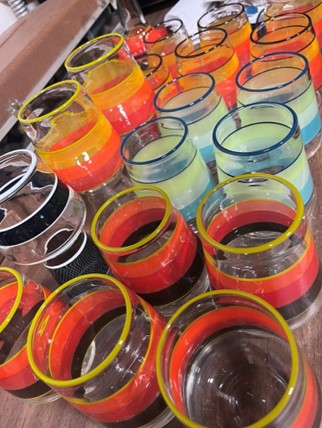Reed Rogala of Wisconsin owns and operates a glass business where he crafts beautiful pieces of functional glass art. In the following article, Reed Rogala discusses the fascinating world of glassmaking technology, uncovering the advancements, benefits of quality glassware, and the entrepreneurial spirit driving innovation in the industry.
In the realm of craftsmanship, few mediums embody the delicate balance between science and art quite like glassmaking. From the ancient techniques of glassblowing to cutting-edge innovations in glass technology, the intersection of science and art has fueled a continuous evolution in the creation of exquisite glassware.
Reed Rogala Explains the Art and Science of Glassmaking
Glassmaking is a centuries-old craft that combines scientific principles with artistic expression to shape molten glass into intricate designs and forms. At its core, the process of glassmaking involves heating silica-based materials, such as sand, soda ash, and limestone, to high temperatures until they melt and form a viscous liquid. This molten glass is then shaped, manipulated, and cooled to create a wide array of glass products, ranging from delicate ornaments to durable containers.
One of the most iconic techniques in glassmaking is glassblowing, which dates back to ancient Mesopotamia. In this method, skilled artisans gather molten glass on the end of a hollow tube called a blowpipe and shape it by blowing air into the tube and manipulating the glass with tools and molds. This hands-on approach allows artisans to create unique and intricate glass objects, showcasing their craftsmanship and artistic vision.
Advancements in Glassmaking Technology
Reed Rogala explains that while traditional glassmaking techniques continue to thrive, modern advancements in glassmaking technology have opened up new possibilities for innovation and creativity. One such advancement is the development of specialty glasses with enhanced properties and functionalities.
For example, borosilicate glass, commonly called Pyrex, is known for its high durability and thermal resistance, has found applications in laboratory glassware, cookware, and scientific instruments. Reed Rogala utilizes borosilicate glass in his work. Below he provides more details on borosilicate glass and its applications:
- Composition: Borosilicate glass primarily consists of silica (silicon dioxide, SiO2) and boron trioxide (B2O3) as its main components. The addition of boron trioxide to the silica matrix alters the structure, resulting in distinct properties.
- Thermal Expansion: One of the most notable characteristics of borosilicate glass is its extremely low coefficient of thermal expansion. This means that it expands and contracts very minimally when exposed to temperature changes. As a result, this product is highly resistant to thermal shock, making it ideal for applications where sudden temperature variations occur, such as glassware, cooking utensils, and industrial equipment.
- Durability: Due to its low thermal expansion, borosilicate exhibits exceptional durability and resistance to breakage, even when subjected to rapid temperature changes or mechanical stress. This durability makes it suitable for demanding applications where safety and reliability are critical.
- Chemical Resistance: It is also highly resistant to chemical corrosion from acids, alkalis, and other harsh chemicals. This property makes it suitable for use in chemical laboratories, pharmaceutical manufacturing, and the production of storage containers for corrosive substances.
- Clarity and Transparency: Offering excellent optical clarity and transparency, makes it suitable for applications where visibility is important, such as laboratory apparatus, optical lenses, and lighting fixtures.
- Versatility: Borosilicate is available in various forms, including tubes, rods, sheets, and custom-molded shapes, allowing it to be used in a wide range of applications across different industries.
- Applications: Additionally, borosilicate finds extensive use in laboratory equipment such as beakers, flasks, test tubes, and pipettes due to its thermal and chemical resistance. It is also commonly used in the production of cookware, including bakeware, measuring cups, drinkware and glass cooktops. Additionally, borosilicate is utilized in the manufacturing of high-quality glass art, pharmaceutical packaging, solar panels, and telescope mirrors, among other applications.
Overall, its unique combination of thermal, mechanical, and chemical properties makes it a versatile material that plays a vital role in various industries and applications where durability, safety, and reliability are paramount.
Another notable advancement is the introduction of automated glass manufacturing processes, which leverage robotics, precision machinery, and computer-controlled systems to streamline production and ensure consistency in quality. These automated processes enable manufacturers to produce large quantities of glassware efficiently while maintaining strict adherence to design specifications and performance standards.
Benefits of Quality Glassware
Quality glassware offers a multitude of benefits, making it a preferred choice for various applications in both domestic and commercial settings. Reed Rogala of Wisconsin says that one of the primary advantages of quality glassware is its durability and longevity. Unlike plastic or ceramic alternatives, glassware is resistant to scratches, stains, and odors, ensuring that it remains pristine even after repeated use.
Additionally, glass is non-porous and inert, making it ideal for food and beverage storage as it does not impart any flavors or chemicals to the contents. This property also makes glassware easy to clean and maintain, promoting hygiene and food safety.
Furthermore, Reed Rogala of Wisconsin notes that quality glassware enhances the sensory experience of consuming food and beverages, allowing users to appreciate the color, aroma, and texture of their favorite culinary creations.
Whether it’s a clear glass mug that showcases the rich hues of a freshly brewed coffee, or stemless wine glass and decanter, the visual appeal of quality glassware adds an extra dimension to the dining experience.
 Entrepreneurship in the Glassmaking Industry
Entrepreneurship in the Glassmaking Industry
Reed Rogala of Wisconsin highlights that the glassmaking industry presents ample opportunities for entrepreneurs to carve out their niche and make a mark in the market. Whether it’s designing innovative glassware products, establishing a boutique glass studio, or leveraging e-commerce platforms to reach a global audience, entrepreneurship in the glassmaking industry offers endless possibilities for creative expression and business success.
Reed Rogala’s 27 Unlimited is a functional glass company that utilizes state of the art materials, techniques, and designs. Their products, such as their stemless wine glasses and decanters are resistant to extreme fluctuations in temperatures, durable, and dishwasher safe. The creations embody a fusion of traditional glass techniques with a fresh, modern perspective. Rooted in the legacy of American flameworking, Reed Rogala’s work represents a natural progression in the evolution of glass art.
For other aspiring entrepreneurs, a passion for craftsmanship, a keen eye for design, and a commitment to quality are essential ingredients for success in the glassmaking industry. By staying abreast of the latest trends and technologies, cultivating relationships with suppliers and collaborators, and fostering a strong brand identity, entrepreneurs can position themselves as leaders in the field and differentiate their offerings in a competitive market.
Conclusion
Reed Rogala explains that the fusion of science and art in glassmaking technology continues to captivate and inspire artisans, designers, and entrepreneurs around the world. From ancient traditions to modern innovations, the evolution of glassmaking reflects humanity’s enduring quest for beauty, functionality, and excellence. As we celebrate the rich legacy of glassmaking craftsmanship, let us also embrace the boundless possibilities that lie ahead, as entrepreneurs and visionaries continue to push the boundaries of what is possible in this timeless art form.
For more on Reed Rogala visit his website http://27unlimited.com/ to shop and view his latest creations.








